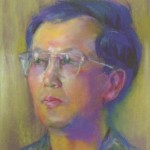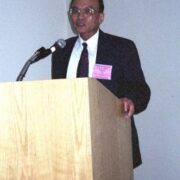No More Pain
Emerson M. F. Jou, M.D.
 Soft Tissue Injury—the Culprit!
Soft Tissue Injury—the Culprit!
As a specialist in Physical Medicine and Rehabilitation, I have seen thousands of patients suffering back pain over the years. During my first several years of practice, I followed the textbooks, medical journals and seminars in addition to the teachings of my professors for diagnosis and treatment. Even with my best effort, I was unable to cure back pain, leaving me and my patients very frustrated. This bothered me quite a bit. I just could not accept the notion that back pain is incurable in this high-tech modern era. Therefore, I took a step back, trying to figure out why back pain is such a tough problem. I soon suspected that back pain must have come from muscles instead of spine or nerves. I then redirected my focus and started treating muscle injury, consistently obtaining satisfactory results, even cure in some cases.
Having many questions, yet little knowledge and no books or teachers for guidance regarding muscle injury, I had to search alone in the dark for answers without knowing where to go or what to look for. Relying on common sense and keen observation, I learned a great deal from carefully examining and treating my patients. I also analyzed all available treatments and tested most of them. I began to see some light through the inner working of pain. I was able to break the myths, one after the other, and eventually come out of the maze. After considerable experience, I was finally convinced that back pain is actually derived from soft tissue injury, not bone spur, herniated disc, pinched nerve, sciatica, arthritis or other spinal conditions. Therefore, I determined: A diagnosis with no regard to soft tissue injury is deemed to be a misdiagnosis; a treatment with no regard to soft tissue injury is deemed to be ineffective.
I unknowingly stumbled into a new field of “soft tissue injury”. I was surprised and shocked to find how primitive and uncultivated this field is in modern medicine. No wonder there are numerous errors in the diagnosis and treatment of back pain as well as other pain-related conditions. In diagnosis, the cause of pain is often misleading, non-specific or unknown, not pointing to the real source. In treatment, based on a misleading diagnosis, | it is understandably out-of-focus, ineffective and largely symptomatic relief at best, but no cure. Thus, so many pain-related conditions remain unresolved for years despite all medical resources. Patients have suffered so much for so long, still longing for a cure. How unfortunate it is, but how wonderful it will be to have a cure!
In my early efforts, I treated only the injured muscle and managed to soften its tight nodule. Later I realized that its attachments must also be treated and used a slightly different technique to treat them.
I also understood that muscle strength is a key element in the diagnosis of pain. Pain interferes with muscle exertion and limits the output of strength; thereby most of muscle weakness is actually strength limited by pain. Once pain is removed, strength returns to normal immediately. Thus, muscle strength can be utilized as a reliable factor in diagnosis as well as in measurement of the efficacy of treatment.
In addition, I knew that exercising an injured muscle often irritates and worsens its injury. I always tried to resolve the injury without any strengthening exercise.
Then I found that fascia plays an essential and utmost important role in pain. This new concept was monumental! I devised a way to treat fascia injury effectively.
It has taken me quite some time, through trial and error, to find ways of identifying the precise source of pain and the optimal method of curing pain. All these years, I have been sharpening my skills to master the simplest, most effective and efficient techniques to cure pain. Initially, I applied vigorous massage trying to break down tight muscles, based on physics. Although still somewhat effective, it hurt my patients and my hands. There is also the limitation that massage cannot be done to certain small parts of the body. I attempted various existing and creative methods searching for a better solution for years in vain. One day I tried light touch on a patient who was scared of pain and accidentally discovered a previously unknown physiology that light touch elicits body response reversing injured tissue to its normal state, and thus pain disappears. Light touch works very well on the muscle and especially the fascia. It can be applied to soft tissue injury of any site and size. I have since replaced physics with physiology so that painful injury can be quickly resolved and there is little pain hurting my patients or my hands during treatment. This simple, low-tech, highly efficient and truly effective method has become a terminator of injury and the very tool to cure pain.
The same principles of diagnosis and treatment can be successfully applied to pain anywhere in the body, even extending to other pain-related conditions.
Little by little, over a thirty-year span, I have accumulatively established the theory and application of The Precision Method using Touch-and-Hold & Stretch-and-Hold techniques for soft tissue release. With this method, injured sites are precisely identified and effectively treated toward a cure. Any pain-related condition can definitely recover regardless of new or old, mild or severe, body part or location. There is no need for expensive tests, medications, injections or surgeries, and medical costs can be greatly reduced. I am excited; hoping eagerly that this breakthrough brings good tidings to those in need.
This book is written entirely based on my personal understanding and clinical experience and for the first time to introduce “The Precision Method”.
Emerson M. F. Jou, M.D., M.P.H.
周明峰 醫師
Website: NoMorePainClinic.com
Posted in 2015/02





